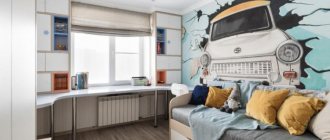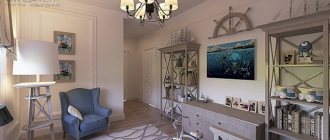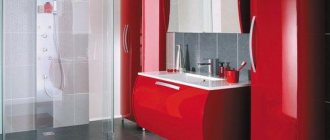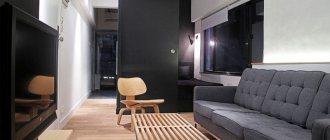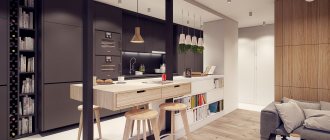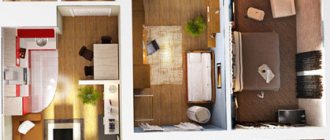In order for your child to have good academic performance, it is important to properly design his learning area. This will be discussed in the article.
When your child becomes a school student, it completely changes his way of life, which means that his room must undergo significant changes. After all, now the child will not only sleep and play in it, but also learn and create, the number of his things will increase significantly. Taking this into account, parents should take care in advance to ensure that the design of the children's room best suits the growing needs of the growing student.
Schoolchild's room: design, general recommendations
- If there are two children in a family, then you need to think through the design of a schoolchild’s room for two so that they do not interfere with each other’s studies. But you can save on sleeping space by installing a bunk bed.
Together
- You need to understand that a girl’s schoolroom and a boy’s room should be different from each other. In addition, it is better to divide the entire space of the room into zones, fill it with soft colors, functional furniture, provide proper lighting, and be sure not to forget about the play corner. We will consider all these nuances below.
- As noted above, a student’s room should carry a multifunctional load - from the bedroom to the study. Therefore, it is extremely important to create zones that differ in functionality and, accordingly, in design and content. This will help discipline the baby and not distract his attention, switching, for example, from books to toys. And it’s much easier to clean in a zoned space.
Zoning
- To divide an entire room into functional zones, it is not necessary to arrange multi-level ceilings or floors - it is enough to correctly arrange furniture and other interior items. For example, install a wardrobe with sliding doors facing the sleeping area, and equip it with shelves on the opposite side, thus forming a functional “wall” for a work or play area.
- Another option is a portable screen or partition, which, on the one hand, will create a cozy privacy at your desk, and on the other hand, you can hang children’s drawings, photographs, and the like on it.
Student's room
- It happens that for some reason it is impossible to zone a room (for example, due to its limited size). Then you can simply place the desk in one corner (so that the baby sits behind it with his back to the toys), and move the bed and play area to the far corners.
Room for two children
It is especially important to properly zone a room for two children. Every child should have at least a minimum personal space for play, study and relaxation. Corners should be designed in accordance with personal preferences and interests. This will not only avoid unnecessary conflicts between children, but will also give everyone space for self-expression and personality formation. It’s great if you can combine personal interests and maintain a common style.
If two schoolchildren live in a room, it is important to take care of a separate workspace for each. This will allow one of the children not to wait while the other does his homework.
A popular design option for sleeping arrangements for two children is a bunk bed.
Color design of a schoolchild's room
- If you do not plan to carry out major renovation work in the nursery every year, such as repainting the walls or re-gluing the wallpaper, then it is better to opt for a neutral color scheme. This will allow you to make adjustments over time to the interior of a child’s room for a schoolchild (furniture, decoration, decorative elements) without spending too much money and effort.
In calm colors
- Another advantage of calm colors in the interior is their positive impact on the psyche of a growing schoolchild. After all, the right colors will help you concentrate in the work area and relax in your bed for a good rest.
Boy's room
- Psychologists advise arranging some bright oases - interior details on which the eye will linger. But there shouldn’t be too many of them, and always against the background of light walls and ceilings (ideally they should be white in combination with beige, soft gray, green and blue).
Vivid details
- For a work corner, colors that stimulate attention and encourage successful activity are suitable: soft, muted yellow, greenish, blue, orange and brown. Moreover, there can be quite a lot of green, and the rest of the colors should simply be “present” in the work corner in the form of the same accents (it is best if this is some important information - such as a lesson schedule or daily routine - done on a colored background).
Color spectrum
The main colors in the interior are determined depending on the technical parameters of the room and the girl’s preferences. Don't think that each of them dreams of a pink room with frills and glamorous trinkets. But even if your daughter has such a desire, you need to offer her a combined option. The best choice is neutral shades that go well with any other colors.
The following colors are best used as a background:
- White color does not carry an emotional load, has a beneficial effect on the psychological state, and also masks surface defects and gives lightness to the space;
- beige, light gray - increases confidence, calms, balances, while visually increasing the size of the room, favorably highlighting any interior items;
- pale lilac is the best replacement for pink shades;
- green – improves mood, promotes the creative process, quickly calms and speeds up falling asleep;
- light blue – relaxes well, reduces emotionality, but reduces concentration, therefore not suitable for the work area;
- yellow - normalizes the emotional and mental state, activates mental activity and physical activity (for a hyperactive child, it should be diluted with milky, beige or other pastel inserts).
It is recommended to choose color combinations depending on the theme and age of the girl. In any case, when adding bright accents to a neutral background, you should combine no more than 2-3 shades.
Furniture for a schoolchild's room
- Not only comfort, but also health – and directly – depends on the ergonomics of furniture for a schoolchild’s room. And since children grow quickly, it is better for them to purchase tables and chairs “with a reserve” so that they can, if necessary, adjust their height and backrest angle.
Choose quality furniture
- The modern furniture market offers a lot of all kinds of furniture for a schoolchild’s children’s room, and in order to make the right choice, you need to either consult with a specialist or choose a table and chair yourself.
- You need to understand that the optimal height of the table surface is considered to be the approximate chest level in a sitting position (a couple of centimeters lower), and the hands should lie on the tabletop without any tension or sagging.
Important Rules
- If the chair turns out to be too high , then you can build a footrest from scrap materials (boxes, books, etc.), involving the small owner of the room in this process.
Measurements
- Most likely, there will not be enough space in the room to place two tables - a desk and a computer, so immediately purchase some kind of hybrid and make sure that it has a sufficient number of drawers and shelves - this will help save space.
Comfort and space are important
Storage systems (cabinets)
For small children's rooms, you can use storage systems that are part of multifunctional structures, or built-in wardrobes, if there is a niche or storage room suitable for their installation. Such arrangement options will save square meters and make the room visually more spacious - examples and tips on choosing a closet for a girl can be found in a separate article.
In a medium to large room, a good option would be cabinet furniture - closed cabinets, walls, chests of drawers. If you want to rearrange them, they can be easily moved, which cannot be said about built-in structures.
Schoolchild's room: lighting
- It is very important to think through the arrangement of furniture and zoning of the children's room so that the work area is sufficiently illuminated - both by natural light and by lighting fixtures.
- The main parameters of illumination should be uniformity, the absence of excessive dimness or brightness - and this applies to both sunlight and the operation of lamps.
- If you plan to hang a central lighting fixture, then you should definitely add additional lighting sources to it - either around the entire perimeter of the room (with stationary built-in lamps) or in certain areas of it (using sconces and table lamps).
Lamps
- In the working corner of the student's room , on the desk (on the left - for those who write with the right hand, and on the right - for left-handers), it is necessary to place an adjustable table lamp so that you can easily change its angle and height. It is best to use a 60-watt white LED bulb with a matte effect.
Need additional lights
- If the student’s desk is near a window, then it is advisable (if possible) to install it perpendicular to the opening.
The play corner is a schoolchild’s favorite place in the room
- When your baby becomes a schoolchild, he never ceases to be a child, which means that his favorite area in the room will be the play corner.
- That is why the design of a schoolchild’s room from this perspective needs to be thought through very carefully.
In order for games not only to kill the baby’s time, but also to help him develop properly, it is worth planning the appropriate decorative elements:
- planes for creativity (if your child has a penchant for drawing), for learning (all kinds of magnetic or writing boards and the like);
- tables for games, puzzles, crafts or other creative activities;
- musical instruments;
- sports equipment (wall bars, horizontal bars, ropes).
Bright board Game corner Compact
Gaming side
It is advisable to put a soft hypoallergenic covering on the floor, because the child will spend a lot of time on it.
SAFE CHILDREN'S ROOM
Despite the fact that the student begins to grow up, we should not forget that, first of all, he is still a child. Avoid arranging furniture with sharp corners in the design of his room; install plugs in sockets. When choosing lamps, give preference to those that do not have glass parts. When choosing textiles for windows, do not make them as long as the floor; if you step on them, not only the tulle, but also the cornice may fall on the child. Be sure to install handles with locks on the windows, and on the door opposite, it is better to insert the handle without a lock. Any heat source is protected with protective panels.
Decorative elements in a schoolchild's room as developmental aids
- In any case, you will want to decorate the student’s room with some decorative elements - so why not combine, as they say, business with pleasure?! Let the real “highlight” of the nursery be the decorations chosen with wisdom and love that carry an educational meaning.
- You can stick a huge map of the world (stylized as an antique one, with hidden pirate treasures), put a globe, hang a model of the solar system or the whole starry sky with the main constellations from the ceiling - in fact, there can be a lot of ideas.
World Map Map
- If your child is interested in creativity , then hang reproductions of famous paintings or portraits of writers or composers on the walls. And if he has a penchant for learning languages, then look for wallpaper with the alphabet.
Paintings
- Any parents are undoubtedly proud of their child’s successes - so share his victories with everyone who comes to visit you. To do this, it is enough to create a kind of “honor board” on which you can place the child’s most successful drawings, and, over time, all kinds of certificates and awards, cups and medals.
- The main rule for arranging a “honor board” is the most prominent place in the room, so that it immediately catches the eye of everyone who enters.
- It’s good if you take the time and relatively little money to insert all these awards into frames under glass - this way they will look much more solid and will last longer.
Mini library in a schoolchild's room
- Everyone knows that only a child who reads develops harmoniously and comprehensively. So create all the necessary conditions for your child to become an avid book lover!
- Collect his own library with him (bookshelves, racks or cabinets are perfect for this), and also equip a cozy place for reading in the student’s room, which will be fairly well lit.
In the play area
Books
- To create maximum comfort, invite your child to decorate the bookshelves with some miniature objects (toys, souvenirs, etc.).
A place to store things, toys, school supplies in a student’s room
- It is necessary to initially think through the interior of the nursery in such a way that all categories of items have their place in it - and in sufficient quantities. Then it will be much easier to clean the room, and there will be no clutter.
- Of course, your baby will gradually accumulate quite a lot of all kinds of things: clothes, toys, school supplies, and so on, which he will not want to throw away or remove from his room.
We store things
- School supplies should be stored in a work area and in such an order that they can be easily reached (desk drawers, shelves, cabinets, bedside tables). Objects that the child constantly uses should be placed closer.
Storage
- Clothes in the student's room should be placed in a wardrobe (recommended depth - 40 cm). The hanger bracket should not be located too high - approximately at the child’s eye level. Pay attention to the drawers: they must not slip out of the grooves so that the baby cannot accidentally injure himself. Another option for storing clothes is a chest of drawers for linen and an open hanger for things that need to be stored on hangers.
- Try to teach your child that toys that he no longer plays with should be gradually disposed of: for example, by giving them to someone younger, and the remaining ones should always be put back in their place after play. Otherwise, you will simply drown in their huge number!
We need to put things in order
- It’s a good idea to store toys in special boxes - having previously organized them according to a principle convenient for the baby.
Zoning
In the design of a children's room for a teenager, the issue of zoning is one of the main ones. This is necessary so that the child can do his homework without being distracted by less important matters. The thing is that it is very difficult for a child who just yesterday did nothing but games and entertainment to switch to serious matters. On the other hand, proper division of the room area will leave enough space for both games and hobbies; in addition, you will not have to allocate additional space in the apartment for entertainment.
Recreation area
It is important to understand that academic success does not depend on cramming, but on the opportunity to relax, change your field of activity and restore strength. Therefore, the interior of any teenage nursery should include a comfortable sleeping area. Modern schoolchildren are very fond of sleeping areas with so-called attics. In the upper part there is a comfortable sleeping place, and in the lower part there is a place for games and activities.
A comfortable children's room is one where each functional area is separated from the other.
When choosing multi-level models, remember that there must be enough light at each level. This means that lamps should be installed on both the upper and lower tier.
Zoning and ordering of the room helps the student to better concentrate on certain tasks.
Study area
The modern learning process makes its own adjustments to the organization of study space at home. Today you can’t do without a computer desk, shelves for storing school supplies, as well as for all kinds of computer elements.
The first and most important thing you need for studying is a desk and chair. They are usually placed near a window that provides plenty of natural light.
In addition, you need to correctly position the table - the main workplace of a teenager. It is very important to have enough natural light. To avoid unnecessary strain on the eyes, the light should fall from the left side. The best option is when the table is installed directly in front of the window.
School age is a transition to adulthood, so furniture and decoration that were appropriate in a child’s room are no longer suitable for a first-grader.
If the doors to the room are located exactly behind the child’s back, this will negatively affect his nervous system, since he will subconsciously be in a state of constant anxiety and fear. Take this fact into account when choosing a place to install your desk.
Experts advise positioning the work area so that the student sits perpendicular to the front door: from a psychological point of view, this position is considered the most comfortable.
As already mentioned, you can’t do without a computer, which means it is recommended to immediately purchase a computer desk, at which you can not only get acquainted with modern technologies, but also prepare homework in various subjects. Today, computer desks are offered in a wide range, so you are guaranteed to find an option that suits you in size and design. Please note that the size of the table must be sufficient not only to install a monitor, but also to place an open textbook and notebook on it.
It is better if the table is located near the window.
Another important attribute of the work area is a chair or chair at the table. Straight posture largely depends on the correct height of the chair and table. The ideal option is a special school chair, the height of which can be adjusted.
A table lamp is considered an obligatory “companion” of the table. After all, natural light is not always enough, and a chandelier on the ceiling does not provide the necessary lighting.
Place to play
Another important component of a children's room. Just because your child has gone to school does not mean that he needs to forget about his favorite toys and entertainment. Psychologists do not advise putting everything that can entertain (or distract) into the far corner. There should be a place and time for everything. It is recommended to plan your day so that classes alternate with games and hobbies.
And as the child grows up, the “contents” of his room will change.
Toys will be replaced by a TV and musical instruments or sports equipment.
But, as a rule, until about the age of 14, it is still difficult for a teenager to decide what exactly he wants, what he should strive for, and therefore the issue of furnishings and zoning is decided by the parents alone. But at the age of 14, when a boy (or girl) is aware of his actions and goals, it is very important to make a joint decision about the arrangement of the room.
For the bed, the corner where the child feels most comfortable is usually chosen: in a country house it is an attic with a sloping roof, in an apartment it is a niche.
Storage space
The older a child gets, the more things he has, so a room for a schoolchild (and even more so, a room for a schoolgirl) should have a wardrobe or chest of drawers in its interior. After all, in addition to school uniforms, you need somewhere to hang everyday things, as well as sports uniforms. If space and design allow, you can equip several shelves for shoes. By the way, it is not at all necessary to install one bulky cabinet.
Perhaps a pair of small cabinets or shelving would be a more practical solution in your interior.
An interesting fact: the sooner a child has his own place to store things, the faster he learns to have order, to the need to put his clothes and shoes (and even toys) in a strictly designated place. This makes the baby, and then the teenager, more organized and collected.
As you can see, decorating a student’s room requires spending a lot of time and effort. The main difficulty is to correctly combine both the relaxation area and the workspace, to make sure that the child wants to return to his room. If possible, choose furnishings and decorations with your teen. Believe me, it will bring you closer.
Most younger schoolchildren prefer to sleep near the wall.
